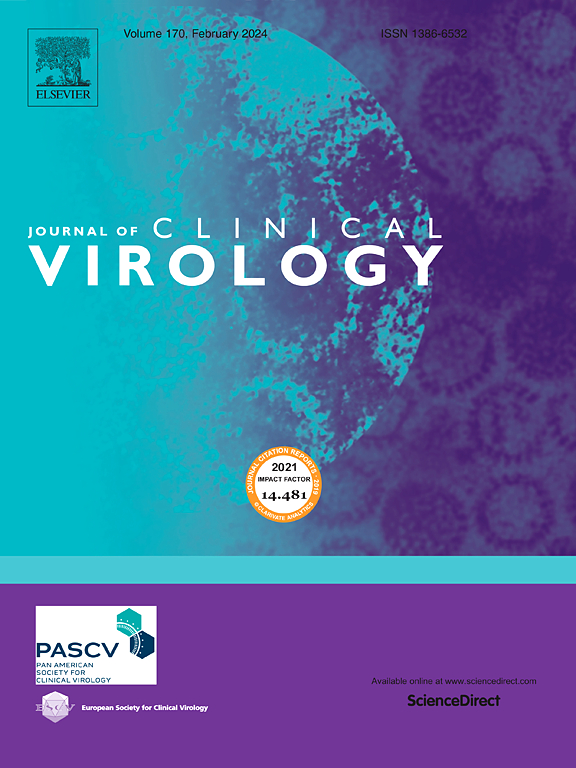Clinical performance of the BD Onclarity™ HPV extended genotyping assay for anal cancer screening: a prospective pilot study
IF 3.4
3区 医学
Q2 VIROLOGY
引用次数: 0
Abstract
Objectives
To evaluate the clinical performance of an extended HPV genotyping assay for anal cancer screening in high-risk populations and investigate the prevalence of high-risk HPV (HR-HPV) genotypes in patients diagnosed with anal intraepithelial neoplasia grade 2 or worse (AIN2+).
Study design
A prospective cohort study was conducted at the European Institute of Oncology, Milan, Italy, from September 2022 to September 2024. A total of 202 high-risk individuals were enrolled. Anal samples were collected using a brush in ThinPrep PreservCyt from all subjects for HPV testing and genotyping; cytology was performed unless histology was already available. Associations between variables and sex were tested. Sensitivity, specificity, and predictive values for AIN2+ relative to HPV status were calculated. HR-HPV genotype prevalence was analysed in the overall population and among AIN2+ cases.
Results
The final study population comprised 192 subjects due to 10 invalid samples. No significant associations were found between patient characteristics and sex. Sensitivity, specificity, positive predictive value (PPV), and negative predictive value (NPV) were 87.7 % (95 % CI: 76.3–94.9), 72.6 % (95 % CI: 64.3–79.9), 57.5 % (95 % CI: 46.4–68.0), and 93.3 % (95 % CI: 86.7–97.3), respectively. Approximately 30 % of subjects were diagnosed with AIN2+. HR-HPV genotype distribution was similar between women and men. HPV16 was predominant in AIN2+ cases (>70 %), followed by the 33/58 and 56/59/66 pools in women.
Conclusions
Extended HPV genotyping may support anal cancer screening strategies by providing a potential standalone tool for both screening and triage. Further studies are needed to confirm these findings in larger cohorts.
用于肛门癌筛查的BD Onclarity™HPV扩展基因分型检测的临床表现:一项前瞻性试点研究
目的评价扩展HPV基因分型检测在高危人群肛门癌筛查中的临床表现,并调查高危HPV (HR-HPV)基因型在诊断为肛门上皮内瘤变2级或更糟(AIN2+)患者中的流行情况。研究设计一项前瞻性队列研究于2022年9月至2024年9月在意大利米兰的欧洲肿瘤研究所进行。共有202名高风险个体被纳入研究。所有受试者的肛门样本使用ThinPrep PreservCyt毛刷收集,进行HPV检测和基因分型;除非已有组织学资料,否则行细胞学检查。测试了变量与性别之间的关联。计算AIN2+相对于HPV状态的敏感性、特异性和预测值。在总体人群和AIN2+病例中分析HR-HPV基因型患病率。结果无效样本10份,共192人。患者的特征和性别之间没有明显的联系。敏感性、特异性、阳性预测值(PPV)、阴性预测值(NPV)分别为87.7% (95% CI: 76.3-94.9)、72.6% (95% CI: 64.3-79.9)、57.5% (95% CI: 46.4-68.0)、93.3% (95% CI: 86.7-97.3)。大约30%的受试者被诊断为AIN2+。HR-HPV基因型在男女之间分布相似。HPV16在AIN2+病例中占主导地位(70%),其次是女性中的33/58和56/59/66。结论扩展型HPV基因分型可为肛门癌筛查和分类提供潜在的独立工具,从而支持肛门癌筛查策略。需要进一步的研究在更大的队列中证实这些发现。
本文章由计算机程序翻译,如有差异,请以英文原文为准。
求助全文
约1分钟内获得全文
求助全文
来源期刊

Journal of Clinical Virology
医学-病毒学
CiteScore
22.70
自引率
1.10%
发文量
149
审稿时长
24 days
期刊介绍:
The Journal of Clinical Virology, an esteemed international publication, serves as the official journal for both the Pan American Society for Clinical Virology and The European Society for Clinical Virology. Dedicated to advancing the understanding of human virology in clinical settings, the Journal of Clinical Virology focuses on disseminating research papers and reviews pertaining to the clinical aspects of virology. Its scope encompasses articles discussing diagnostic methodologies and virus-induced clinical conditions, with an emphasis on practicality and relevance to clinical practice.
The journal publishes on topics that include:
• new diagnostic technologies
• nucleic acid amplification and serologic testing
• targeted and metagenomic next-generation sequencing
• emerging pandemic viral threats
• respiratory viruses
• transplant viruses
• chronic viral infections
• cancer-associated viruses
• gastrointestinal viruses
• central nervous system viruses
• one health (excludes animal health)
 求助内容:
求助内容: 应助结果提醒方式:
应助结果提醒方式:


